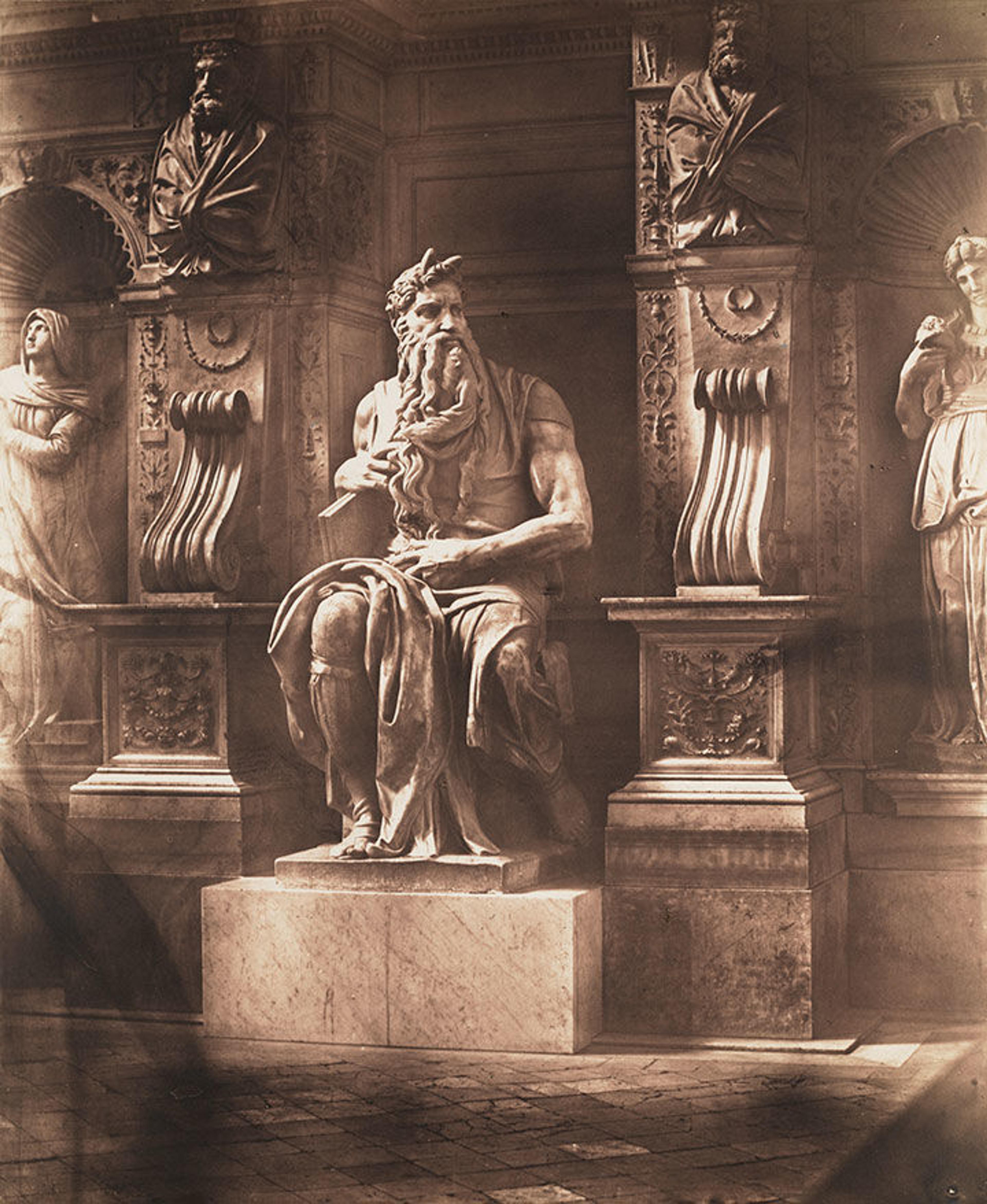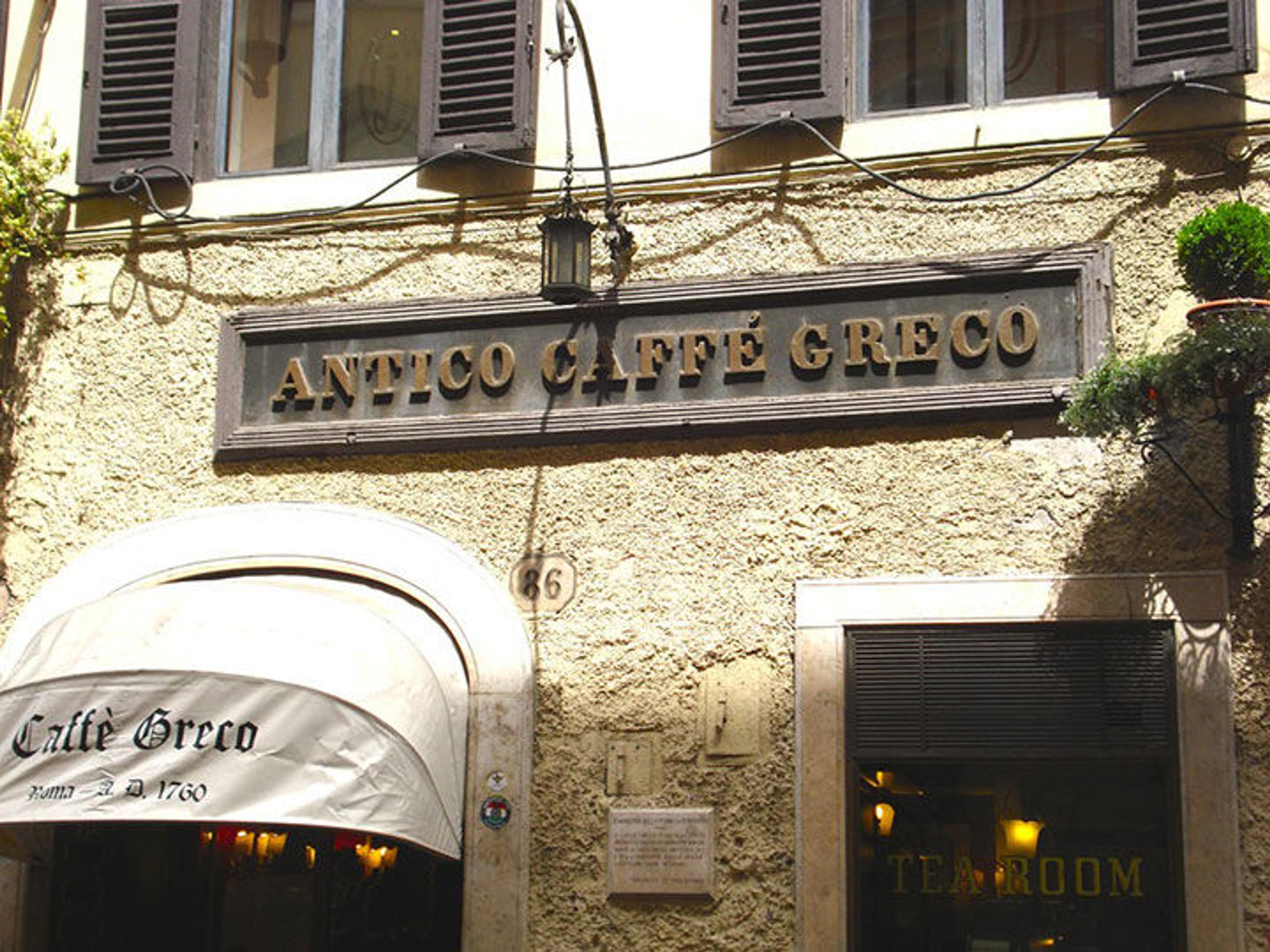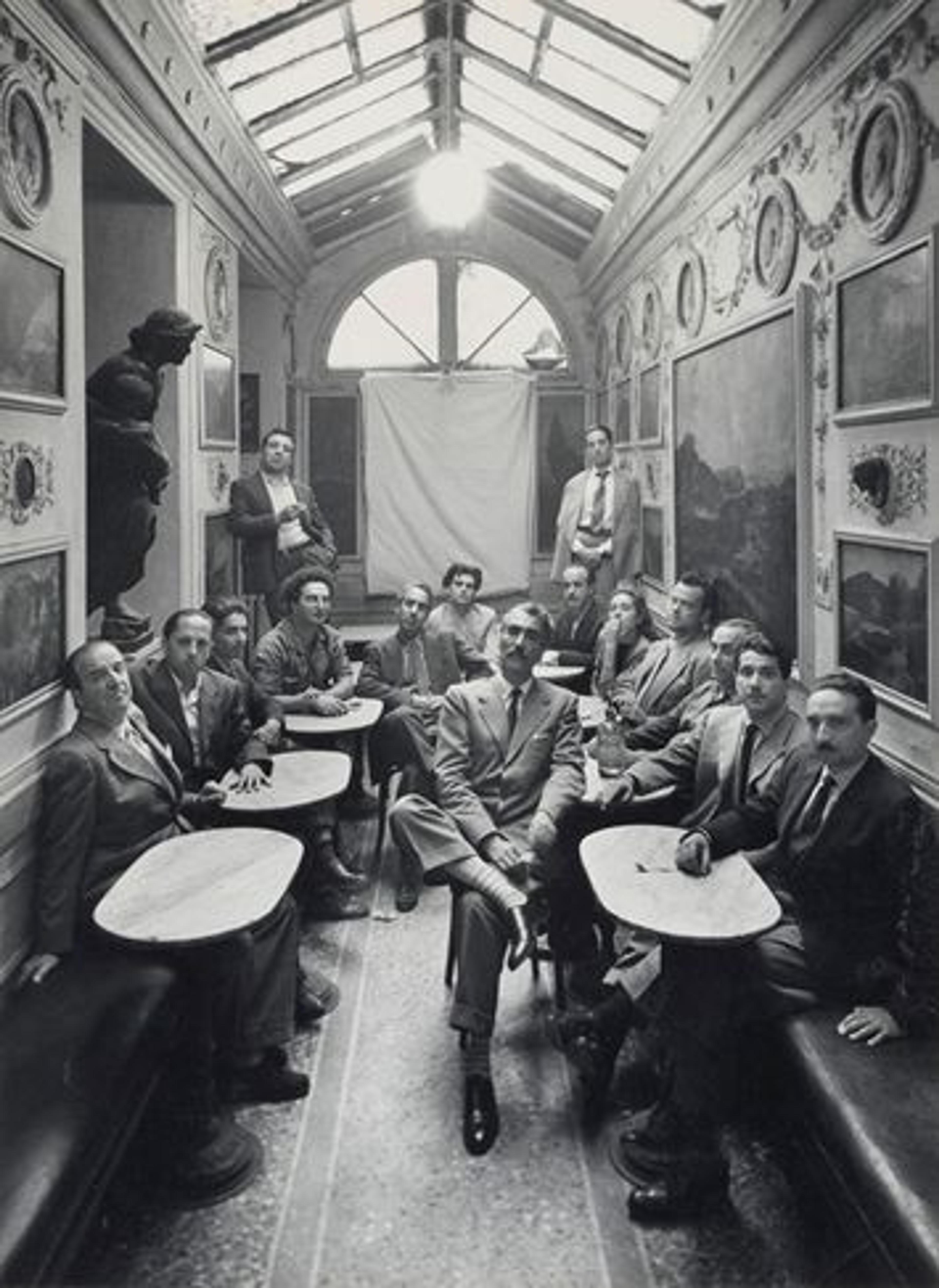
Ludwig Passini (Austrian, 1832–1903). Küstler im Caffè Greco in Rom [Artists in the Caffè Greco in Rome], 1856. Watercolor, 49 x 62.5 cm. Hamburger Kunsthalle, Hamburg
In the first place a word about Roman photographers. I need hardly say that their places of rendezvous are the Lépre and the Caffè Greco. . . . I would recommend any one visiting Rome, with the intention of following this absorbing pursuit repair at once to the Caffè Greco.[1]
— Richard W. Thomas
«Although art-making is often perceived as a solitary activity, artists have long sought inspiration and camaraderie in larger communities. Professional and informal organizations—from guilds to academies, clubs to colonies—have provided artists with social and creative stimulus. But what about stimulus of another kind? Cafés, which emerged in Europe in the 18th century, encouraged sociability and intellectual exchange with cups of coffee. In Rome, the Caffè Greco in particular served as a stomping ground of artists and intellectuals for roughly two centuries, so it is perhaps no surprise that it also became a meeting-place for photographers.»
Established in 1760 and still in business today, the Caffè Greco is situated just off the Piazza di Spagna at the foot of the Spanish Steps. This neighborhood has been particularly popular among artists because of its proximity to the French Academy at the Villa Medici. Historically, the Caffè Greco was surrounded by hotels, trattorie, and shops catering to the tourists and artists who flocked to the area, and served as an important center of exchange among people of different nationalities who may not have otherwise met.

Left: Giacomo Caneva (Italian, 1812–65). View from the French Academy at the Villa Medici, ca. 1852. Salted paper print, 7 7/8 x 10 11/16 in. (20 x 27.2 cm). The Metropolitan Museum of Art, New York, Gilman Collection, Museum Purchase, 2005 (2005.100.855). Right: Carlotta Cortudino, ca. 1852. Salted paper print, 5 5/16 x 7 13/16 in. (13.5 x 19.9 cm). The Metropolitan Museum of Art, New York, Gilman Collection, Museum Purchase, 2005 (2005.100.799)
The establishment's register of clients records the signatures of several key figures from a group of photographers who became known throughout Europe for their early success with paper negatives and for spreading information about the emerging medium of photography to artists and amateurs passing through the Eternal City. Active from around 1847 to 1853, they included the Italian vedutista (landscape painter) Giacomo Caneva, the French sculptor and medalist Frédéric Flachéron, the painter Eugène Constant, the architect Alfred-Nicolas Normand, the British painter James Anderson, and the Scottish doctor-turned-painter Robert Macpherson. This international group of artists has since become known as the Roman School of Photography, or the Circle of the Caffè Greco after the historic café where they often gathered. Photographs by these artists and other pioneers of the medium are currently on view at The Met through August 13, 2017, in the exhibition Paradise of Exiles: Early Photography in Italy.
Filled with young bohemians and intellectuals, the Caffè Greco provided a public space for discussing artistic and political ideas. Of course, the café offered other enticements too. In 1816, one patron noted that it was "the only place where one could smoke tobacco unlike the other cafés, where the thing was prohibited, or at least limited to an isolated table."[2] A common claim among customers suggested that the the Caffè Greco's coffee could quickly cure a hangover.

James Anderson (British, 1813–88). Michelangelo's Moses, ca. 1854. Salted paper print, 15 11/16 x 12 3/8 in. (39.8 x 31.5 cm). W. Bruce & Delaney H. Lundberg Collection
William Mitchell Gillespie (1816–68), an American engineer and author, recorded the lively and cosmopolitan atmosphere during a visit to the café in the early 1840s:
The Caffé Greco [is] the general rendezvous of the artists of all nations. . . . When you enter, you find the smoke so dense that you can scarcely see across the room, but through it dimly appear the long beards, fierce moustaches, slouched hats, slashed velvet jackets, frogged coats, and wild but intellectual countenances, which characterize most of the young artists of Rome.[3]
Within the energetic setting of the café, the photographer Macpherson stood out from the crowd with his bright red hair, Scottish brogue, and signature kilt. He was known for both his love of practical jokes and for his exceptional photographs made using glass negatives—guidebooks of the period hailed his prints as among the finest in Rome.

Exterior of the Antico Caffè Greco today. Photo by the author
For photographers associated with the Roman School, the Caffè Greco and its proximity to the French Academy fostered an artistic community that encouraged new technical and aesthetic developments for an emerging medium and a ready clientele for artists' studies and souvenirs of Roman views. Caneva's photographs of peasants, which were staged on the terrace of his studio, were especially prized by artists and Flachéron sold photographic equipment and prints from his art supply shop in the neighborhood. Both men were known to give lessons to enthusiasts passing through the city and made joint excursions with their cameras into the countryside surrounding Rome.
Connections to the French Academy also put these photographers in contact with influential collectors like the Duchesse du Berry and Alfred Bruyas, a patron of Gustave Courbet whose catalogues indicate that he owned an early group of photographs by Flachéron and Constant.
Left: Irving Penn (American, 1917–2009). A Group of Intellectuals in Caffè Greco, Rome, 1948. © The Irving Penn Foundation

The Roman School of Photography emerged during the heyday of the Caffè Greco, when many luminaries of literature, music, and art—especially the protagonists of Romanticism—frequented the establishment. Among them were writers Johann Wolfgang von Goethe, Lord Byron, Percy Shelley, John Keats, Nikolai Gogol, Nathaniel Hawthorne, Mark Twain, and Stendhal; artists Jean-August-Dominique Ingres, Paul Delaroche, Pierre-Paul Prud'hon, Bertel Thorvaldsen, Jean-Baptiste-Camille Corot, and members of the Nazarene movement; and composers Richard Wagner, Hector Berlioz, and Franz Liszt.
The legacy of the Caffè Greco as a favorite haunt for artists extended well into the 20th century, which is epitomized in a 1948 photograph by Irving Penn. (Vogue published another version of the picture, made during the same sitting, the following year.) Penn transformed the sky-lit room known as the "omnibus" into a makeshift studio for a group portrait of Italy's leading intellectuals. The photograph—made by one of the masters of the medium—affirms the importance of the Caffé Greco as a landmark of the history of photography.
Notes:
[1] Richard W. Thomas, "Photography in Rome," in The Art-Journal 14 (May 1852): 159.
[2] Quoted in Maria Elisa Tittoni, "Il Caffé Greco: 'le petit café le plus plaisant du monde,'" in Roma 1850: Il Circolo dei Pittori Fotografi del Caffé Greco (Milan: Electa, 2003): 13.
[3] William Mitchell Gillespie, Rome: As Seen by a New-Yorker in 1843-4 (New York: Wiley and Putnam, 1845): 133.
Related Links
Paradise of Exiles: Early Photography in Italy, on view at The Met Fifth Avenue through August 13, 2017
Heilbrunn Timeline of Art History: "The Rise of Paper Photography in Italy, 1839–55"
